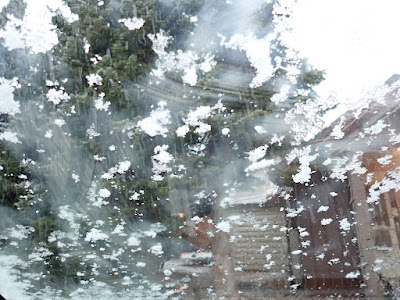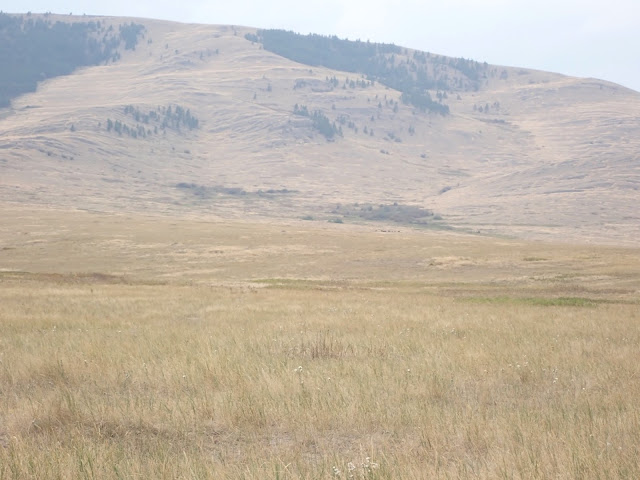31 October 2021
Continuing with our trip, we drove from Missoula to West Yellowstone, which is just outside the west entrance to Yellowstone National Park. We both had enjoyed our drive through Yellowstone on our trek across the country 
It's a road trip, not a race to the finish line. The journey is part of the trip, it's just as important as the 
Well, it turns out that West Yellowstone is at an elevation of 6,667 feet (or 2.03 kilometres). As in, a high elevation. We approached West Yellowstone in a rain storm. And drove around the town, looking for an affordable hotel, in the 
By the time we found the Pioneer Motel, a collection of cozy cabins, it was full out snowing. Our 
Yes, our cabin was 
The next morning was a bit icy, so we held off driving until some of the ice and snow melted. Then we joined the throngs waiting to enter Yellowstone.
It really was beautiful in early autumn. The aspen and birch trees (or maybe alder? the white bark trees) were turning golden and orange, a beautiful contrast against the deep green evergreens on the hills. The meadows were gold and amber, the sky cleared and was a soft blue, and it really looked 
Turns out that the direct route through Yellowstone and then south through to Jackson was closed for construction work. That meant instead of driving into the park and driving directly south, we had to drive east, then south, then a bit west, all around the other three sides of a square to meet up with the highway that would take us south to Jackson.
Okay, not a problem, that meant more time in the park, more time to view the animals and meet more bison. Maybe even a wolf or two, or a bear if they weren't hibernating already.
It turned out that as we drove into the higher elevations of the park, we encountered more snow. It had snowed here as well the previous day and night. It was cold enough that the snow stayed.
The bison didn't seem to mind, it was just a couple of inches of snow. They could easily push the snow out of their way and still munch on the grasses. There were several herds of bison down near the river, and later on in the day up a bit of a hill. I even saw several bison hoof prints in the mud left behind as the snow melted!


It was beautiful, as always. There's a reason this area is set aside as a national park as well as an animal sanctuary.
Eventually, we starting driving up and down mountains. It began to 
The "no traction" light lit up on the dashboard (who knew such a warning light existed???), and I said something about that to Richard. He said well here's a button (near the parking brake), and he pushed it. Something happened, because something suddenly gripped and while we did slide a little at that first grip, it definitely became easier to drive in this snowy slush, or slushy snow.
After a while the road headed downward, and our blizzard eased up to just normal snow pelting down. A bit more driving downhill, and we made it to elevations low enough to not have an active snow storm, just accumulated snow again.
Whew!!!
This is actually where we found another herd of bison, as well as a few elk nearby. So, more bison photos. They're so cute. If you look closely, you can see a young bison touching noses with its mother (on the right end of the photo). And two young bison having a little bit of a shoving match (far left side)!


Tons of people were walking by and through the steam, but ugh, it just smells so horrible! The entire parking area near each of these steam vents just stank! I held my breath long enough to get a few photos at one, but most of them were so smelly we didn't even want to get out of the car!! Well, one parking area also had restrooms, and that's where I found the bison hoof prints.


But those majestic peaks were hidden in the clouds, and likely shrouded with the same snow that we had just encountered in Yellowstone.
So we have mysterious and vaguely sinister photos of the Tetons, hiding their secrets in the misty clouds.
The fields and trees in the front made a nice golden foreground for the blue-grey mountains rising in the distance. And yes, there is snow on the sides of the mountains, before they disappear into the grey gloom above.

We drove south to Jackson, and tried to find an affordable hotel. We stopped at some 
So we got directions for the road heading south. I actually found a young woman in her car who used her smartphone to get directions for us. She couldn't comprehend how we drove around without a phone or GPS. I said we use an atlas, and she had no idea what an atlas was. I said it was a book of maps, and we had several maps for each 
Anyway, south we drove, on a small county highway, with more winding around hills and the golden full moon rising in the distance. At twilight, we saw a huge moose standing in someone's yard, eating some greenery. HUGE! And those antlers!!! Wow!!! (I was driving, plus it was a bit dark for a decent photo. But it would have been an amazing picture, with this humongous moose just grazing in a garden!)
We probably drove for about two hours, not even passing a single town! Then suddenly we arrived at a tiny place called Daniel Junction. The actual town of Daniel was a few miles south. But at the junction, there was a gas station with a convenience store that also sold sandwiches and burritos. And, wonder of wonders, they had a motel in the back! YAY! We really were in the middle of nowhere, but the staff people were friendly, the room was clean and warm, and the food was pretty decent. There also was wifi, so we checked in with family, and fell sound asleep.
The next morning we headed south again, and our next stop was the town of Evanston, WY. It was a nice small town, and we decided to spend two nights there while we planned the next leg of our trip. We used the hotel's laundry, drove around the town a bit, found the river, and basically just did some low key exploring.
We thought we both needed a short break after that crazy day of the blizzard and the long evening of driving through the wilderness.
It definitely has given us a taste of what it might have been like during the era of western expansion. Not as rough as travelling on horseback or in a covered wagon, obviously. But travelling through unexpected weather, and not being able to find a place to spend the night, really does make us more aware of the hardships people experienced as they left their homes and headed west to settle in new regions.
It was an experience!



















































